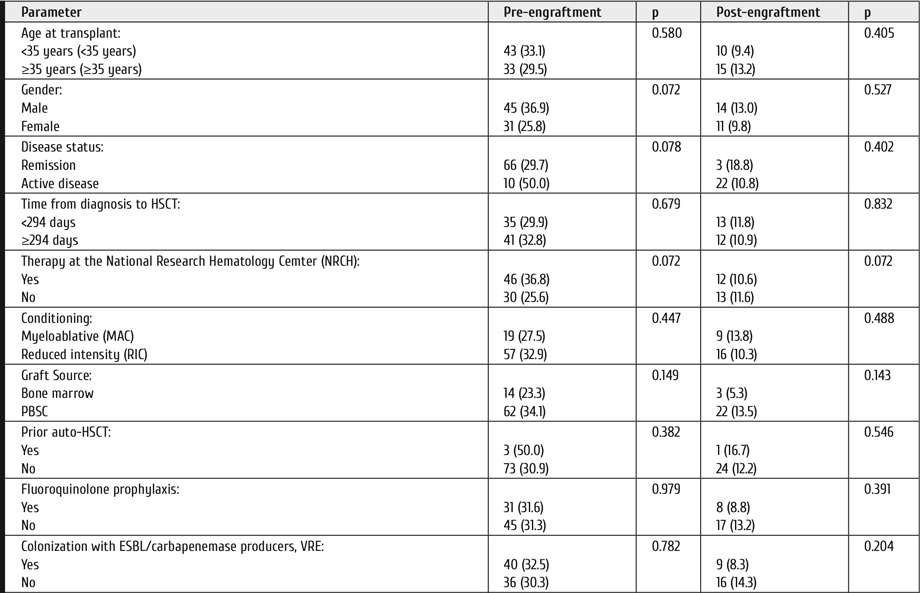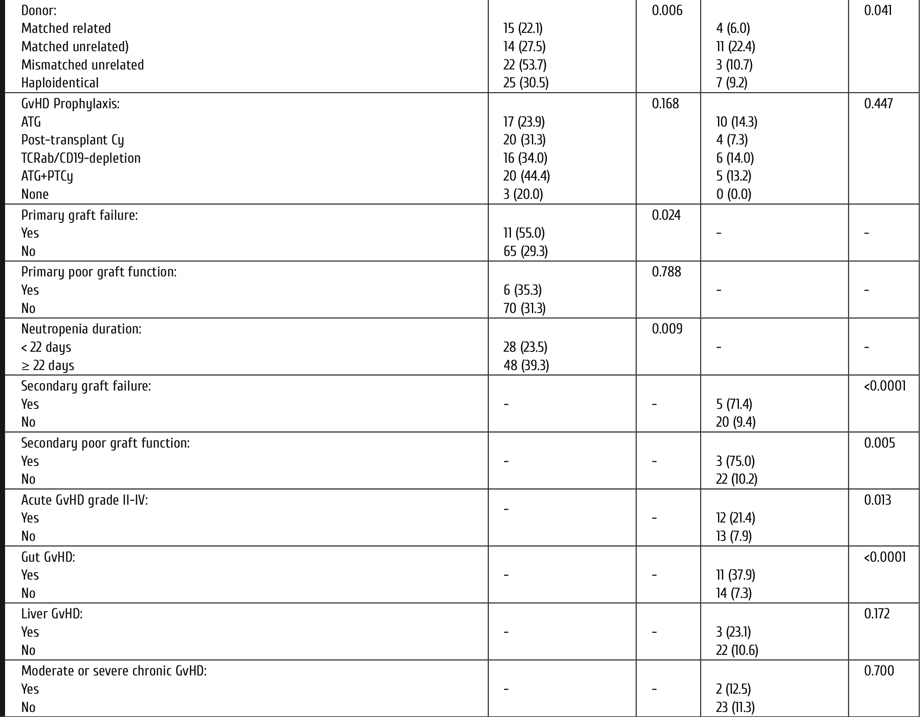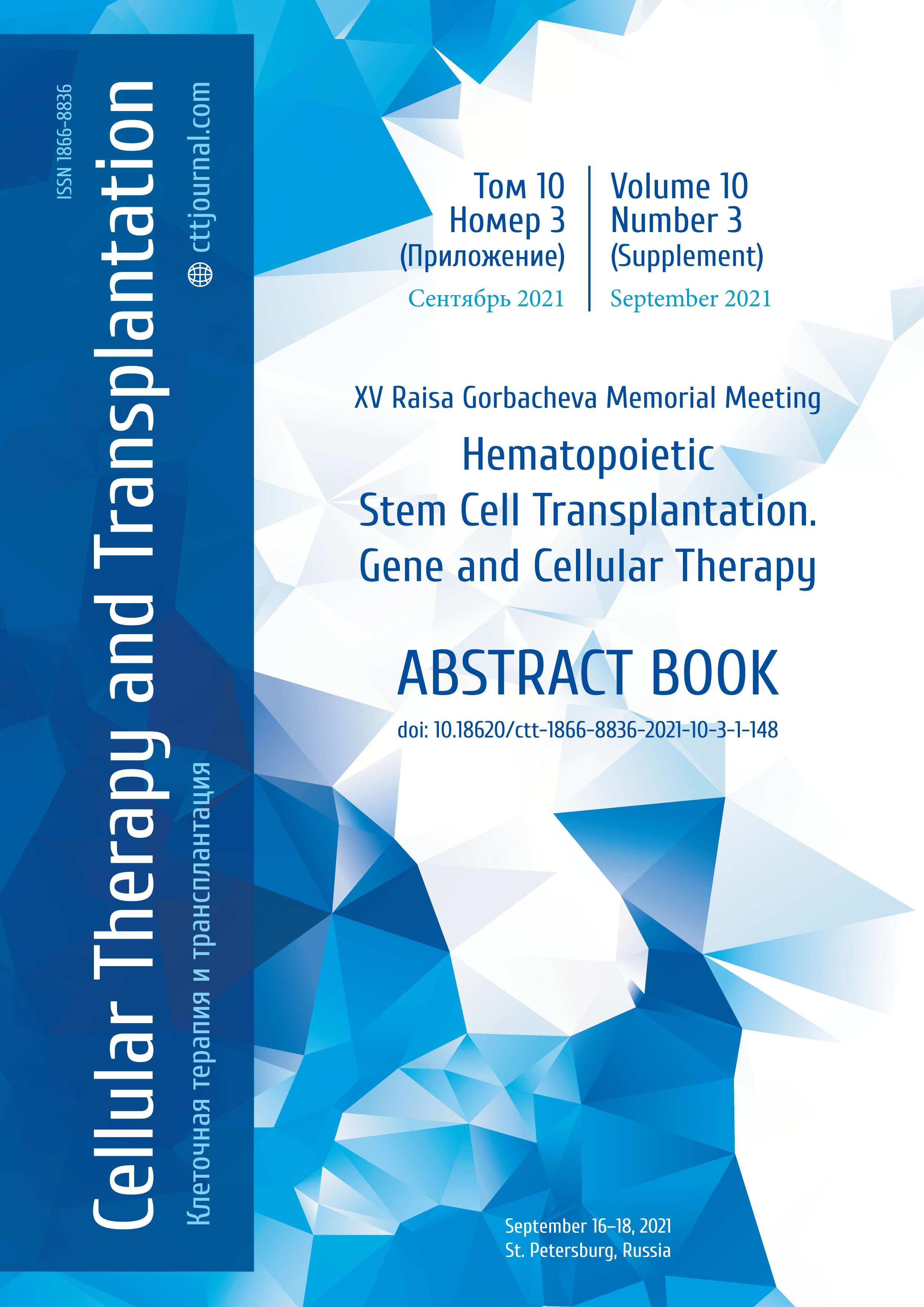PI-01. Risk factors for bloodstream infections after first allogeneic hematopoietic stem cell transplantation
Mobil I. Akhmedov, Galina A. Klyasova, Elena N. Parovichnikova, Larisa A. Kuzmina, Vera A. Vasilyeva, Mikhail Yu. Drokov, Mariya V. Dovydenko, Anastasia V. Fedorova, Natalia N. Popova, Zoya V. Konova, Feruza A. Omarova, Olga S. Starikova, Ulyana V. Maslikova, Ekaterina D. Mikhaltsova, Olga M. Koroleva, Anna A. Dmitrova, Darya S. Dubnyak, Valery G. Savchenko
National Medical Research Center of Hematology, Moscow, Russia
Correspondence:
Dr. Mobil Akhmedov, phone: +7 (926) 180-23-99, e-mail: mobilakhmedov@gmail.com
Summary
Bloodstream infections (BSI) are a major cause of morbidity and mortality among allogeneic hematopoietic stem cell transplant (allo-HCT) recipients. The purpose of this study was to analyze BSI incidence, risk factors and the outcomes after first allo-HCT.
Materials and methods
This retrospective study included 242 patients (50.4% males and 49.6% females) who underwent first allo-HCT in the National Research Center for Hematology during from January 2018 to April 2021. The median age was 35 years (range 17-65 years). Allo-HSCTs were performed from matched related donor (MRD) in 68 (28.1%), matched unrelated donor (MUD) in 51 (21.1%), mismatched unrelated donor (MMUD) in 41 (16.9%), and haploidentical donor in 82 (33.9%) cases. A total of 98 (40.5%) patients without extended spectrum beta-lactamase (ESBL) producing bacteria obtained from rectal swabs received fluoroquinolone-based prophylaxis. Primary and secondary graft failure was detected in 27 (11.2%), and grade II-IV acute GvHD – in 58 (24.0%) patients, accordingly.
Results
Overall, a total of 113 BSI episodes were registered in 95 (39.2%) patients, with one pathogen in 79 cases (83.2%), and 2 or more in 16 (16.8%) patients. The cumulative incidence of pre-engraftment and post-engraftment BSI were 31.0% and 11.0%, accordingly. The median time from allo-HSCT till pre-engraftment and post-engraftment BSI was 8 (range 2-33) days and 64 (range 0-142) days, accordingly. One pathogen was isolated in 94 (82.7%) episodes, two or more – in 19 (17.3%) episodes. A total of 134 different pathogens were isolated: 81 (60.4%) of them were gram-negative, and 53 (39.6%) were gram-positive bacteria. Bloodstream isolates were represented by Escherichia coli (25.3%; n=34), Klebsiella spp (17.9%; n=24), coagulase negative staphylococci (11.2%; n=15), Staphylococcus aureus (9.7%; n=13), Enterobacter spp (9.7%; n=13), streptococci viridans (8.9%; n=12), Pseudomonas aeruginosa (5.9%; n=8), Enterococcus spp (6.7%; n=9), including 6 cases of E.faecium BSI, and other (4.5%; n=6). Among Enterobacter 26.7% (n=19) were ESBL, and 14.0% (n=10) were carbapenemase-producing. In univariate analysis the pre-engraftment BSI risk correlated significantly with donor type, primary graft failure and neutropenia duration of ≥22 days. For post-engraftment BSI, the most significant risk factors were secondary graft failure and poor graft function, donor type, acute GvHD grade II-IV, and acute gut GvHD (Table 1). In multivariate model the pre-engraftment BSI risk was significantly higher in MMUD compared to MRD transplants (HR=2.19; 95% CI:1.08-4.43; p=0.03), wherein post-engraftment BSI cases the most important risk factors were secondary graft failure (HR=30.33 95% CI:8.74-105.20; р<0.0001), poor graft function (HR=18.54 95% CI:4.55-75.62; р<0.0001), and acute gut GvHD (HR=5.62 95% CI: 1.22-25.96; p=0.027). The overall 30-day survival after BSI was 89.9%. It was lower after poly-microbial (76.2%) compared to gram-positive (94.9%) and gram-negative (92.5%) BSI episodes (р=0.06).
Conclusions
Gram-negative bacterial BSI after allo-HCT prevailed in this study. The most significant factors of pre-engraftment BSI were MMUD transplantations, whereas secondary graft failure, secondary poor graft function and acute gut GvHD were associated with higher risk of post-engraftment BSI. Overall 30-day survival was lower after polymicrobial BSI episodes.
Keywords
Hematopoietic stem cell transplantation, bloodstream infections, risk factors.
Table 1. Univariate analysis of pre- and post-engraftment BSI




